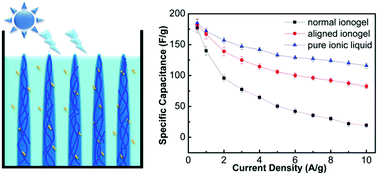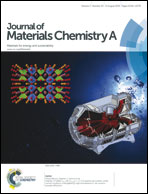Elastic ionogels with freeze-aligned pores exhibit enhanced electrochemical performances as anisotropic electrolytes of all-solid-state supercapacitors†
Abstract
Bio-inspired by bone materials, hierarchical porous materials with aligned structure have been designed and applied in various fields. However, the realization of anisotropic function based on aligned structures is still a challenge. Herein, we prepare nanocomposite ionogel electrolytes with aligned porous structures via a directional freezing of BMIMPF6, PEGMA (PEGDA), and TiO2 at −18 °C and further TiO2-initiated cryopolymerization under UV irradiation. The crystals of PEG derivatives at −18 °C provide a directional template for the formation of aligned porous structures within the ionogel networks. The additional TiO2 nanoparticles, as photoinitiators and nanofillers, endow the aligned ionogels with high mechanical strength. The aligned ionogel-based supercapacitor exhibits anisotropic electrochemical performance and flexibility. The specific capacitance of the device with the vertically aligned ionogel is 172 F g−1 at the current density of 1 A g−1, which is larger than those of the parallel aligned and non-aligned devices.


 Please wait while we load your content...
Please wait while we load your content...